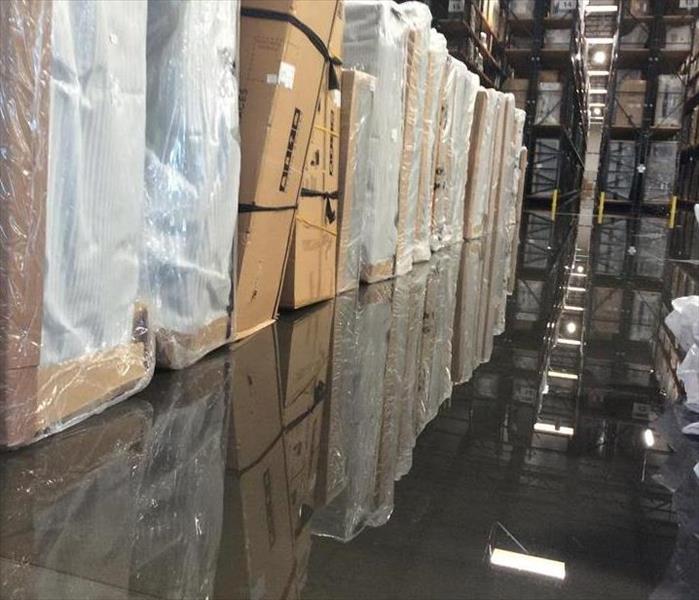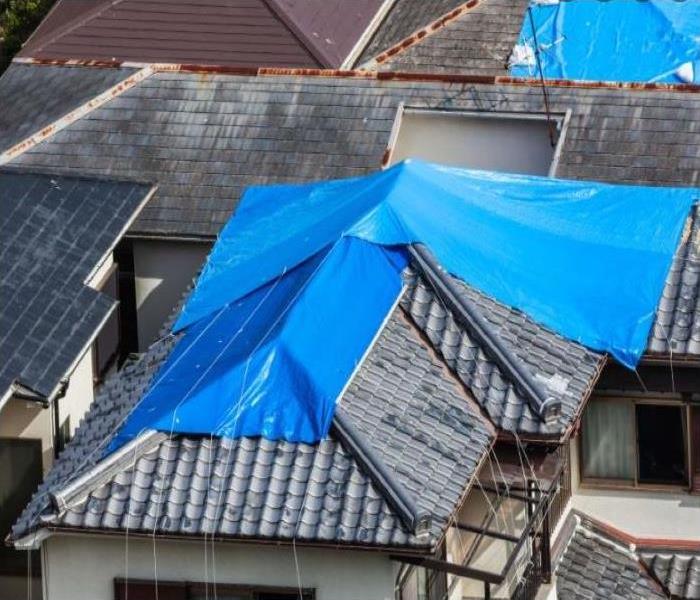With the rain season approaching, why tarp your roof?
8/25/2021 (Permalink)
A roof tarp, when secured properly, can protect your roof from new rain, wind or even snow. It can prevent holes or missing shingles from turning into leaks and can keep existing leaks from getting worse. A tarp can prevent the damaged areas from being affected by excess water and wind, while also keeping water from leaking into your home. A tarp installation can protect your roof up to 90 days until a professional team of contractors can make repairs. We call this a temporary repair.
How to install a tarp:
- Wear the appropriate safety equipment. That includes gloves, goggles, protective clothing, and sturdy boots.
- Use a ladder to reach your roof. Closely examine the area for broken shingles and other areas of damage.
- Homeowners with a steep or slippery roof should assess the damage from the safety of their ladder. Do not step directly onto the roof.
- Carefully clean the debris from your roof using your broom. Removing the branches, leaves and other rubble will give you a clearer view of the damage.
Ways to Protect Your Home From Water Damage
1/26/2021 (Permalink)
Water damage is one of the most common and costliest disasters you may experience as a homeowner. From a burst pipe to a malfunctioning dishwasher or storm damage, there are countless ways water damage could strike your home.
While water damage is a common homeowner headache, there are plenty of things you can do to protect your home from some trying situations.
Protecting Your Home
Not only will you find water damage a hassle to deal with, but the mold that can follow could have a long-term impact on your home. Mold will follow water damage and begins to grow and flourish within 48 hours of exposure to moisture.
When working on ways to safeguard your home from water damage, it is often helpful to break it down by areas of impact. These areas may include basements, kitchens, bathrooms, flooring and ceilings.
You can prevent water damage in the basement by preventing water seepage, which can be done by resealing vulnerable areas of the basement, making sure water drains away from your home and not toward your home’s foundation, and installing a backwater valve.
Many cases of water damage to your kitchen and bathrooms are due to plumbing issues and appliance failures.
Be sure that you regularly:
- Inspect all appliances, paying close attention to hoses and faucets
- Check the seal and caulking around your showers and tubs to make sure they are watertight
- Know the location of the main shut-off valve for water is in your home
- Don’t leave the house while the washer or dishwasher is running
Protecting the possessions in your home from water damage is not always possible, however, there are ways to store items that will at least decrease the amount of damage and loss. It is advisable to use waterproof bins to store items and keep items stored on shelves off of the floor—which is highly recommended when storing your possessions in the basement.
Recovering From Water Damage
You can stand a good chance at salvaging items that can be dried out within 48 hours if your home does experience a water damage situation.
Contact your insurance company immediately, evaluate the extent of the water damage in your home and identify the type of water that is involved.
Here are the three types of water to look for:
Water from rain, condensation or leaky pipes is considered “clean” water.
Slightly dirty water from dishwashers, washing machines, clean toilets, etc. is considered “gray” water.
Water from sewage or serious flooding from nearby rivers, etc. is considered “black” water. This type of water can have harmful health effects.
Following a water damage disaster, you will need to remove wet objects, get your home dried out, dehumidify the area and disinfect remaining materials.
Pro tip: By freezing wet books, photos and papers in a frost-free freezer, you prevent mold and mildew from forming on these items, giving you extra time to deal with them after you have taken care of drying out your home. Once you are able, you can remove them from the freezer and air-dry or fan-dry the pages.
It may seem like recovering from water damage is an overwhelming and slightly impossible task, but it doesn’t have to be. You can call on the highly trained experts at SERVPRO® of Hemet , who are here to make it "Like it never even happened."
Living Spaces Disaster
12/10/2019 (Permalink)
 Flooded Living Spaces Distribution warehouse located in Perris, CA
Flooded Living Spaces Distribution warehouse located in Perris, CA
Fire sprinklers went off all morning and caused this whole Living Spaces warehouse to flood in Perris, CA. This image shows standing water resulting in damages of unboxed furniture that was meant to be for customers. SERVPRO of Hemet acted fast and arrived to the job site and completed the task to mitigate and restore.
San Jacinto Ca
10/24/2018 (Permalink)
 Ramona Humane Society
Ramona Humane Society
Water intrusion in commercial buildings can damage high-value equipment like computers equipment and also building services such as HVAC, lighting, Common long-term consequences of water damage like mold or microbial growth may be more problematic than a home, due to more popularity.
in commercial buildings, flooding can mean extensive loss, and not just in the property offices department. While dealing with actual flood can be stressful, Water from roof leaks penetrating through ceilings. Chronic leakage through the roof may proceed unnoticed for long periods, hidden by suspended ceiling panels or in electrical or HVAC service areas above.
How To Detect Water Damage in your home
6/18/2018 (Permalink)
- Cabinets- signs of rot, delamination, the finish is bubbling.
- Ceiling- discoloration, sagging,bubbling, or peeling paint.
- Floors- discolored grout, stains/watermarks, loose tile.
- Wood Floors- cupping, the boards are dipped in the center and crowning.
- Smell- old, mildew type of smell.
Knowing if you have water damage or not can be difficult to detect because sometimes you would not notice it until it is too late. The five ways mentioned above are great ways to keep an eye out in case if you spot any of these issues. More common examples of water damage in your home could be a recent sink overflow a water leak behind or underneath your sink, toilet line break, ice maker break in your fridge, or dishwasher. If you suspect any of these issues call SERVPRO right away so we can inspect with our thermal cameras for free.






 24/7 Emergency Service
24/7 Emergency Service
